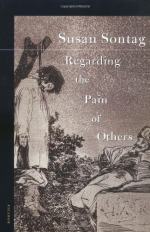
|
| Name: _________________________ | Period: ___________________ |
This test consists of 15 multiple choice questions and 5 short answer questions.
Multiple Choice Questions
1. Which of the following thinkers argued that people take "no small" delight in witnessing the suffering of others?
(a) Aristotle.
(b) Renee Descartes.
(c) Edmund Burke.
(d) Plato.
2. Sontag claims that shock used for rhetorical purposes can become _________.
(a) Dangerous.
(b) New.
(c) Damaging.
(d) Familiar.
3. Sontag claims that some photographs which are "repulsive" can also ________.
(a) Impress.
(b) Allure.
(c) Shock.
(d) Silence.
4. Sontag suggests that Plato anticipated which of the following psychological models?
(a) Pavlov's classical conditioning.
(b) Jung's archetypes.
(c) Skinner's box.
(d) Freud's id, ego and superego.
5. Sontag corrects her earlier argument by claiming that which of the following is eroded by modern media saturation?
(a) Sense of reality.
(b) Human empathy.
(c) Sense of urgency.
(d) Human decency.
6. When Baudelaire expressed his concerns about the effects of the newspaper in 1860, which of the following was true?
(a) Newspapers did NOT yet print images.
(b) Newspapers had begun to sensationalize headlines.
(c) Newspapers had recently become more widely available to the public.
(d) Newspapers had begun printing images alongside the stories.
7. Sontag suggests that photographs do NOT ask which of the following tasks of the viewers?
(a) To put an end to human cruelty.
(b) To retain specific knowledge about each human atrocity.
(c) To work toward peace.
(d) To evaluate the morality of the situation depicted in the image.
8. Sontag suggests that it is still possible to "feel the pulse of Christian iconography" in much war photography. Which famous work of art does she suggest can be seen in W. Eugene Smith's photograph of the woman in Minamata cradling her child?
(a) The Passion of Christ.
(b) Descent from the Cross.
(c) The Last Supper.
(d) The Pieta.
9. Sontag discusses another common belief regarding media coverage of an event, and suggested that it may seem to contradict the first common belief she addresses. What is this second idea?
(a) Overexposure to images in the media makes people callous.
(b) Repeated images in the media exhaust our ability to prevent new atrocities.
(c) The media sensationalizes stories of atrocity.
(d) Limited exposure diminishes the impact the images have on an audience.
10. Which of the following photographers exhibited photographs of Sarajevo in 1994?
(a) Frederick Wiseman.
(b) Larisa Shepitko.
(c) Paul Lowe.
(d) Jeff Wall.
11. Discussing the common person's ability to feel sympathy, Sontag argues which of the following?
(a) People will instinctually distance themselves from suffering.
(b) People will do anything to keep from being moved by what they see.
(c) People will naturally feel empathy, but will quickly distance themselves because society has programmed them to avoid involvement.
(d) People will automatically feel sympathy for victims of atrocity.
12. Sarajevans were angered by a photography exhibit which featured photographs of their suffering alongside images of which other country's people?
(a) Bulgaria.
(b) Somalia.
(c) Rhodesia.
(d) Bosnia.
13. Sontag claims that witnessing atrocity through images is not much different than witnessing them in person. What does she say these activities had in common?
(a) Callousness, exploitation and distance.
(b) Callousness, distance and apathy.
(c) Ease, distance and the ability to be redirected.
(d) Ability to be redirected, callousness and ease.
14. Diorama, tableaux and wax exhibits served which of the following purposes in the eighteenth and nineteenth centuries?
(a) Forms of artistic expression.
(b) Forms of history-as-display.
(c) Forms of entertainment.
(d) Forms of war protest.
15. Sontag begins Chapter 9 with which of the following assertions?
(a) Merely naming an atrocity does nothing to remedy the situation or save its victims.
(b) Images of war do little to help us understand the circumstances of war.
(c) Anti-war imagery is futile.
(d) Designating an atrocity merely labels the victims..
Short Answer Questions
1. Using the example of Ground Zero, Sontag argues that photographs have the power to do which of the following to their subject?
2. _______ is a classic use for the camera.
3. Sontag argues that many people thought that which of the following makes war seem "real"?
4. In transforming an event or person into something that can be owned, photographs:
5. The West had a long tradition of viewing war as which of the following?
|
This section contains 655 words (approx. 3 pages at 300 words per page) |

|




